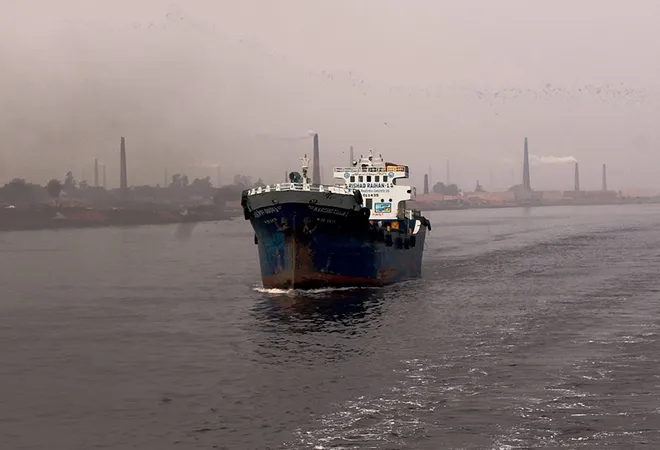 This article is part of the series — BIMSTEC in 2021.
This article is part of the series — BIMSTEC in 2021.
BIMSTEC was founded on 6 June 1997, initially as BIST-EC (Bangladesh, India, Sri Lanka and Thailand Economic Cooperation). Myanmar’s joining in December 1997, renamed the expanded configuration as BIMSTEC. With Nepal and Bhutan joining in December 2004, this new enlarged reconfiguration retained the earlier acronym but ingenuously redesignated itself as ‘Bay of Bengal Initiative for Multisectoral Technical and Economic Cooperation.’ In 2010, it decided to locate its secretariat permanently in Dhaka.
In November 1998, BIMSTEC had identified 14 priority sectors. However, with little tangible progress to show in any, the focus in 2004 shifted to seeking a Free Trade Agreement (FTA). A Free Trade Area Framework Agreement, setting up a Trade Negotiating Committee (TNC), was signed to consider trade in goods and services, investment, economic cooperation and trade facilitation. It has remained essentially a work in progress to date, stymied by efforts to bring SAFTA (The South Asian Free Trade Area) and ASEAN (Association of South East Asian Nations) FTA lists as well as existing bilateral trading/free trading agreements into consonance, as also reconciling gaps between Least Developed Countries (LDCs), middle-income and high-income economies with the grouping. In the 20 years since its inception, it held only two summits — a bleak testimony to the state of political commitment.
There are wide variations in capacities and capabilities, not just within countries domestically, but also between countries in the same region (particularly in South Asia), and between regions.
Trade and connectivity are handmaidens to each other. Trade flows demand a web of efficient multi-modal connectivity and supporting infrastructure being in place, whether overland using roads and railways, or on waters using national and transnational riverine waterways, coastal shipping and maritime shipping arrangements; direct air connectivity between as many points as possible; and a super-fast and efficient digital highway to facilitate processing of required data of goods, services and persons, buttressed by on-ground facilities, like customs, immigration, and phytosanitary stations. In all these matters, there are wide variations in capacities and capabilities, not just within countries domestically, but also between countries in the same region (particularly in South Asia), and between regions. The main impetus for getting this ambitious connectivity web in place must emanate from a determined political will that is in sync intra and inter regionally.
Bangladesh and Myanmar constitute the western and eastern s, respectively, of the geographical and geopolitical bridge that links the South and West Asia region to the Southeast and East Asia regions. Unfortunately, relations between Myanmar and Bangladesh are now at their worst nadir. These vital connector s are in flames where they meet. Unless this raging fire is doused quickly and the bridge repaired, it will hurt all at both ends and beyond. The ambitious overland Trans-Asian and Railway project is being held hostage to the negative dynamics spawned by these bad relations. BIMSTEC can play an important and constructive role in these fire-fighting efforts. Otherwise, it gravely risks ending up in the regional ICU where the South Asian Association for Regional Cooperation (SAARC), formed in December 1985, has been languishing, held hostage by the ceaseless political and military hostility obtaining between India and Pakistan since 1947.
BIMSTEC can play an important and constructive role in the fire-fighting efforts.
While overland connectivity has taken a palpable hit, a maritime route is available through the Bay of Bengal that offers a viable and immediately operational route. BIMSTEC, lest we forget, comprises four South Asian countries, namely Bangladesh, Bhutan, India, Nepal — in the intergovernmental BBIN grouping — along with Sri Lanka and two Southeast Asian countries, namely Myanmar and Thailand. Prior to the collapse of the old colonial order in 1945, the web of multi-modal connectivity that had been admirably established by the British had connected the ports of all these countries, and then stretched it further along the Malaysian and Indonesian coasts to their major shipping entrepot in Singapore, the gateway to the Pacific. The British Crown had used this maritime route, augmented by the railways and roads they built in their colonial possession in the Indian sub-continent and Southeast and East Asia, to enable efficient and significant extraction of resources from these possessions to augment the Crown’s wealth, prestige and power. The Bengal Presidency of British India not only had the highest GDP among its three Indian Presidencies (with the highest per capita income reported in Shillong, the summer capital of that Presidency), it also accounted for over a third of Imperial Britain’s total revenues. With that order fragmenting in the mid-twentieth century, the connectivity web they had established, also became dormant, and underwent atrophy. The revival of that web in today’s context, with the Bay of Bengal as central to it, holds rich promises for all South and Southeast nation-states of today’s world.
Prior to the collapse of the old colonial order in 1945, the web of multi-modal connectivity that had been admirably established by the British had connected the ports of all these countries, and then stretched it further along the Malaysian and Indonesian coasts to their major shipping entrepot in Singapore, the gateway to the Pacific.
Expanding the current BIMSTEC configuration to formally (and logically) also include Malaysia and Indonesia, and reconnecting that maritime link to Singapore, would then embrace all landlocked entities in South Asia to all major entities with interest in ASEAN and beyond. The political will appears to be now surfacing, spurred by the monumental disruption, caused by the COVID-19 pandemic, to the global economy and global, regional, and national supply and value chains that had fueled economic growth and expansion. A BIMSTEC Plus configuration, with a core population of 1.78 billion people (and an additional 490 million of adjacent states with interest), with a combined GDP of close to US$8000 billion, centered around the Bay of Bengal, would facilitate trading between the two regions, making it easier, cheaper and more stable. It would have nowhere else to go except to the stars.
The views expressed above belong to the author(s). ORF research and analyses now available on Telegram! Click here to access our curated content — blogs, longforms and interviews.



 This article is part of the series —
This article is part of the series —  PREV
PREV


